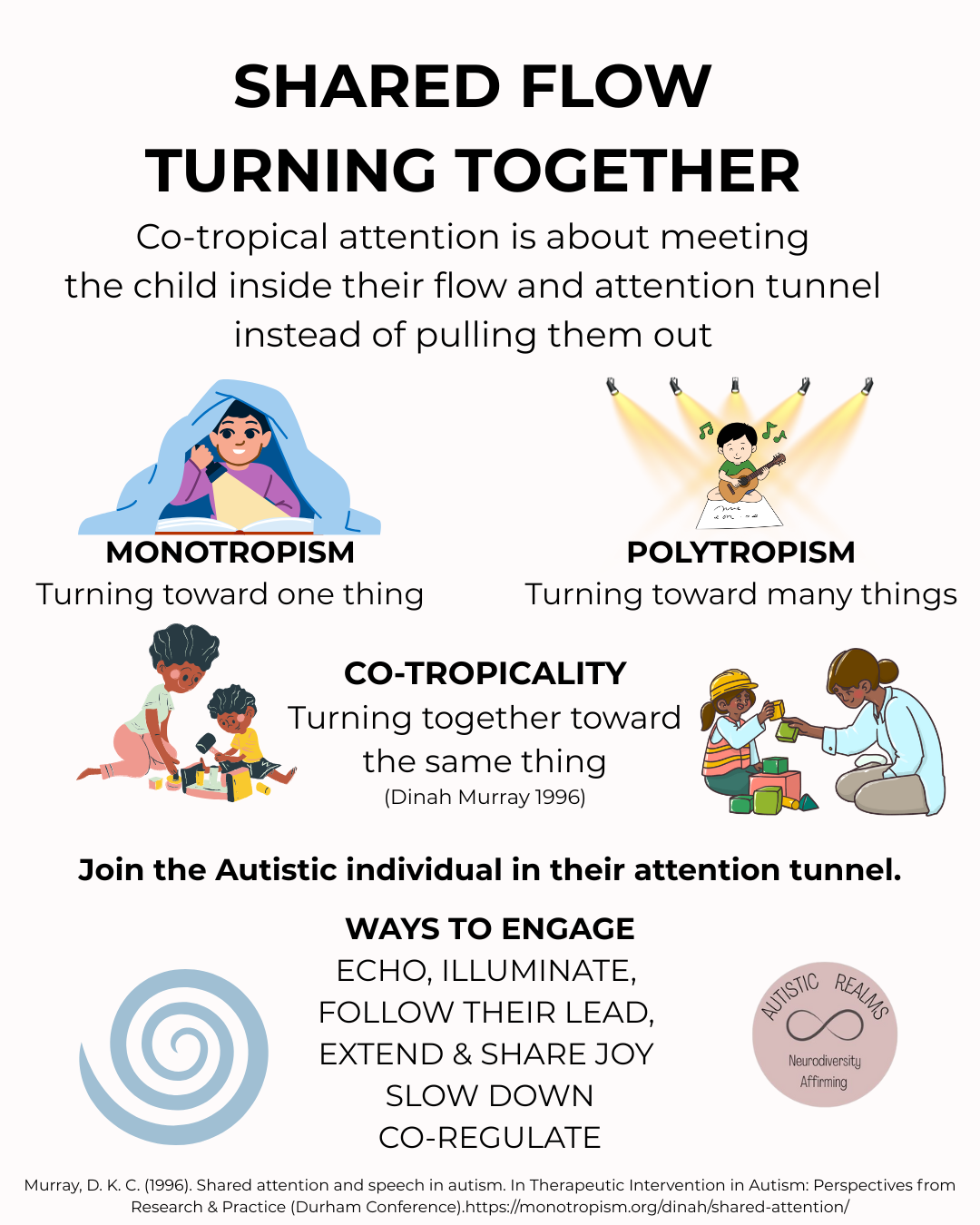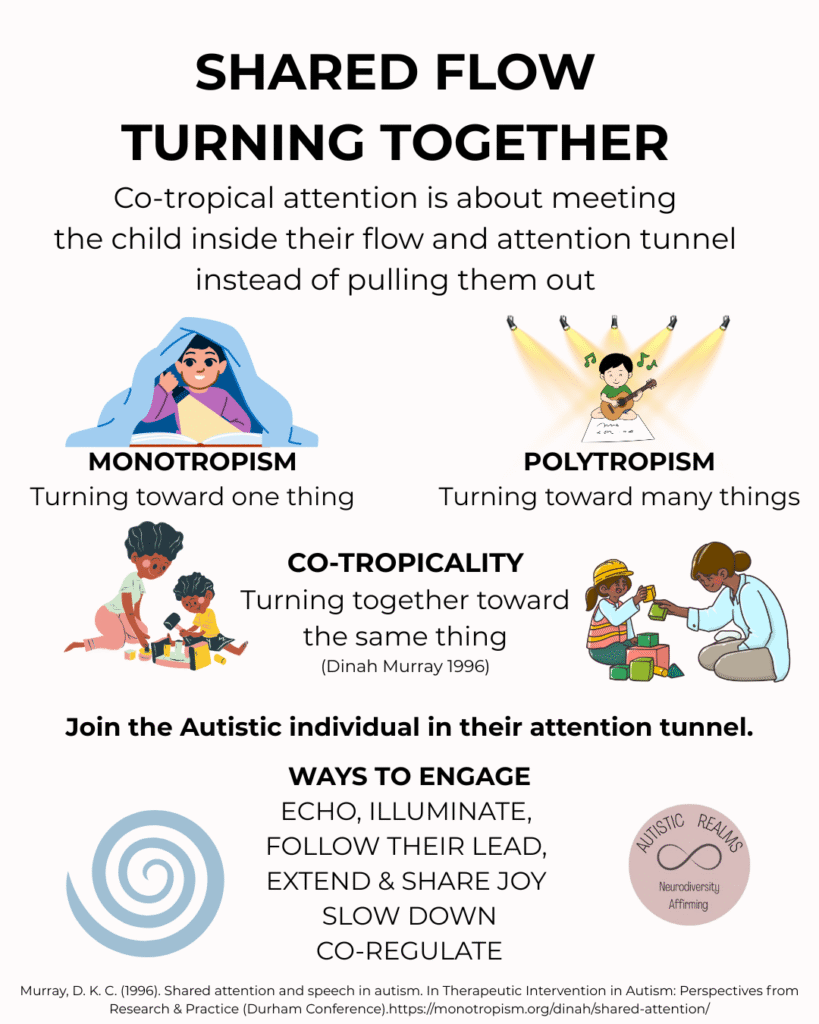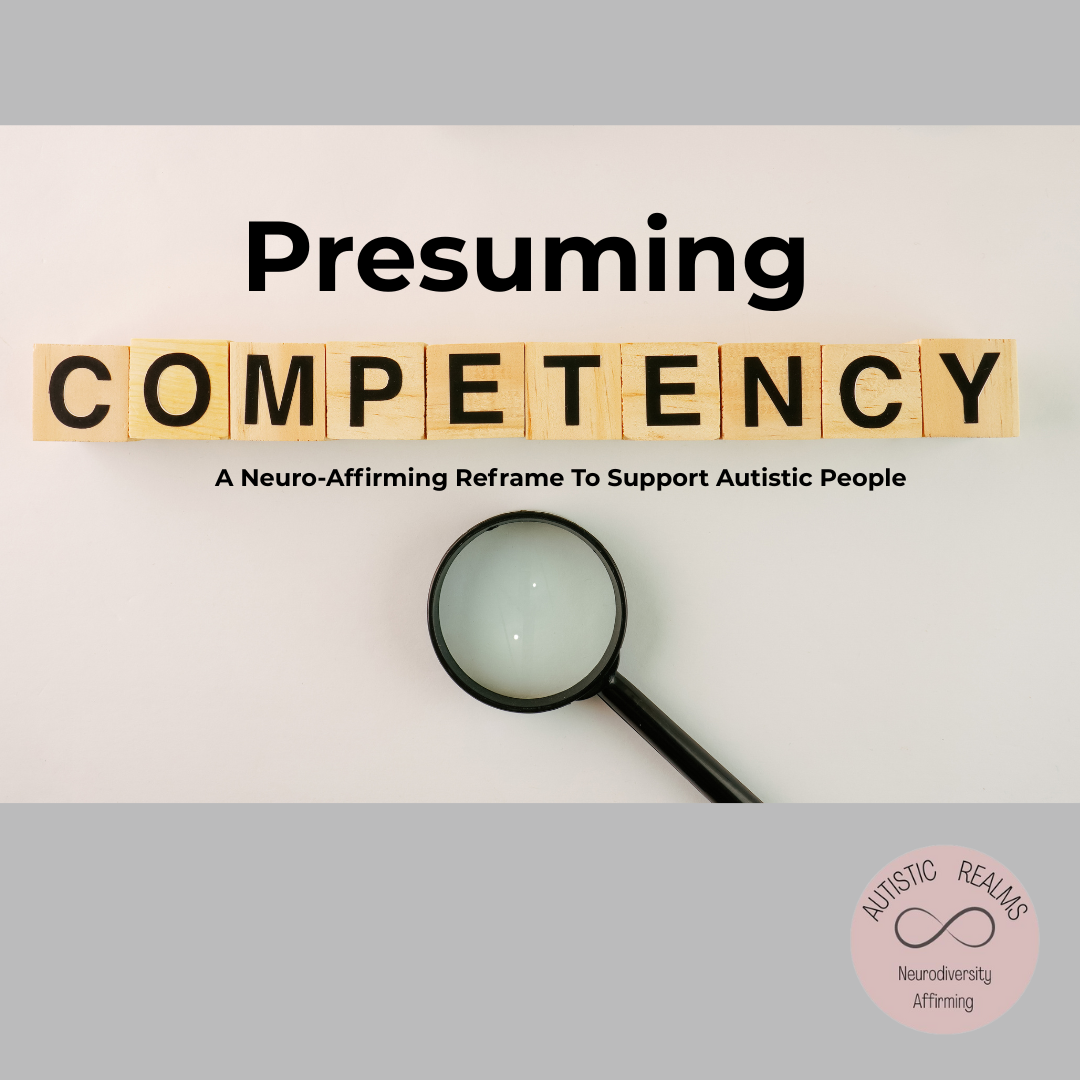Your basket is currently empty!

Shared Flow: Turning Attention To Support Children Together
Co-tropicality is Dinah Murray’s (1996) beautiful term for turning our attention together. From the Greek tropos meaning “to turn” it sits alongside monotropism (turning toward one thing) and polytropism (turning toward many). Co-tropical attention means joining someone within their focused attention tunnel and flow rather than pulling them out of it.
Mono-tropism → mono (“single”) + tropos (“turning”) → turning toward one thing.
Poly-tropism → poly (“many”) + tropos (“turning”) → turning toward many thing.
Co-tropical → co (“together, jointly”) + tropos (“turning”) → turning together or turning toward the same thing.Shared flow and co-regulation.
For Autistic or ADHD children, co-tropical attention can look like adults joining in parallel play, sharing in their passions and intense interests, or may be repeating or echoing a familiar script in a meaningful way (for Gestalt Language Processors).
What Murray calls “sensitive co-tropical attention-giving”, is essentially about starting where the child is, meeting them where they are at, aligning with their rhythms and building trust through shared flow. It’s the same principle behind child-led play and intensive interaction – a tuning in with others. It is neuro-affirming, responsive, deeply respectful and will help build trusting relationships.
When we enter a child’s flowy attention tunnel, we can create safety and build connections. When we slow down, we can turn inwards together towards shared meaning-making, moments of joy and learning. Rather than trying to teach or redirect, we need to adopt neuro-affirming approaches, listen with our whole selves and connect with children where they are at in their flow.
Shared flow is relationship-building in motion; it’s a way of saying, I’m with you, right here, in your world, in your attention tunnel. This is the essence of co-regulation and relational flow, co-creating attention tunnels that resonate between people and grounding connection through shared focus.
When we meet a child inside their flow and attention tunnel, we can build trust and a sense of belonging which are the foundation stones for learning and supporting a person’s wellbeing.

if you share our flow
there’s no telling where you’ll go
but you will learn us
(how else will you meet them?)
A Haiku, by @yeshes.online (shared with permission)
References & Find Out More:
Murray, D. K. C. (1996). Shared attention and speech in autism. In Therapeutic Intervention in Autism: Perspectives from Research & Practice (Durham Conference). Retrieved from https://monotropism.org/dinah/shared-attention/
Murray, D., Lesser, M., & Lawson, W. (2005). Attention, monotropism and the diagnostic criteria for autism. Autism, 9(2), 139–156. https://pubmed.ncbi.nlm.nih.gov/15857859/
Latest Posts
-
Autistic Burnout – Supporting Young People At Home & School

Autistic burnout in young people is real—and recovery starts with understanding. This post offers neuroaffirming ways to spot the signs, reduce demands, and truly support. 💛 #AutisticBurnout #Neuroaffirming #Monotropism #AutisticSupport
-
Monotropic Interests and Looping Thoughts

The theory of monotropism was developed by Murray, Lawson and Lesser in their article, Attention, monotropism and the diagnostic criteria for autism (2005). Monotropism is increasingly considered to be the underlying principle behind autism and is becoming more widely recognised, especially within autistic and neurodivergent communities. Fergus Murray, in their article Me and Monotropism:…
-
Map of Monotropic Experiences

Monotropism seeks to explain Autism in terms of attention distribution and interests. OSF Preprints | Development and Validation of a Novel Self-Report Measure of Monotropism in Autistic and Non-Autistic People: The Monotropism Questionnaire This map highlights 20 common aspects of my personal monotropic experiences. How many do you experience? Where are you on the map…
-
Autistic Burnout – Supporting Young People At Home & School

Being autistic is not an illness or a disorder in itself, but being autistic can have an impact on a person’s mental and physical health. This is due to the often unmet needs of living in a world that is generally designed for the well-being of people who are not autistic. In addition, three-quarters of…
-
The Double Empathy Problem is DEEP

“The growing cracks in the thin veneer of our “civilised” economic and social operating model are impossible to ignore”, Jorn Bettin (2021). The double empathy problem (Milton, 2012) creates a gap of disconnect experienced between people due to misunderstood shared lived experiences. It is “a breakdown in reciprocity and mutual understanding that can happen between people…
-
Top 5 Neurodivergent-Informed Strategies

Top 5 Neurodivergent-Informed Strategies By Helen Edgar, Autistic Realms, June 2024. 1. Be Kind Take time to listen and be with people in meaningful ways to help bridge the Double Empathy Problem (Milton, 2012). Be embodied and listen not only to people’s words but also to their bodies and sensory systems. Be responsive to people’s…
-
Autistic Community: Connections and Becoming

Everyone seeks connection in some way or another. Connections may look different for autistic people. In line with the motto from Anna Freud’s National Autism Trainer Programme (Acceptance, Belonging and Connection), creating a sense of acceptance and belonging is likely to be more meaningful for autistic people than putting pressure on them to try and…
-
Monotropism, Autism & OCD

This blog has been inspired by Dr Jeremy Shuman’s (PsyD) presentation, ‘Neurodiversity-Affirming OCD Care‘ (August 2023), available here. Exploring similarities and differences between Autistic and OCD monotropic flow states. Can attention tunnels freeze, and thoughts get stuck? Autism research is shifting; many people are moving away from the medical deficit model and seeing the value…
-
Monotropism Questionnaire & Inner Autistic/ADHD Experiences

Post first published 28th July 2023 Over the past few weeks, there has been a sudden surge of interest in the Monotropism Questionnaire (MQ), pre-print released in June 2023 in the research paper ‘Development and Validation of a Novel Self-Report Measure of Monotropism in Autistic and Non-Autistic People: The Monotropism Questionnaire.‘ by Garau, V., Murray,…
-
Penguin Pebbling: An Autistic Love Language

Penguin Pebbling is a neurodivergent way of showing you care, like sharing a meme or twig or pretty stone to say “I’m thinking of you,” inspired by penguins who gift pebbles to those they care about.
-
Presuming Competence: A Neuro-Affirming Reframe To Support Autistic People

When “presume competence” is applied without a neuro-affirming lens, it can become a harmful, ableist expectation
-
Ethics & Values of Autistic Realms

Autistic Realms is grounded in values of authenticity, autonomy, and relational care for the human rights of Autistic or otherwise neurodivergent and disabled people. These guiding principles align closely with the ethics and principles of both the Therapist Neurodiversity Collective (TNDC) and the Autistic Self Advocacy Network (which I am a member of – ASAN),…
-
Inclusion Needs Recognition, Not Erasure: A Neurodiversity-Affirming Approach

When headlines claim that autism and ADHD are “invented labels,” it’s more than rhetoric, it’s erasure. A explores why removing neurodiversity from education would harm the very children inclusion is meant to protect.













